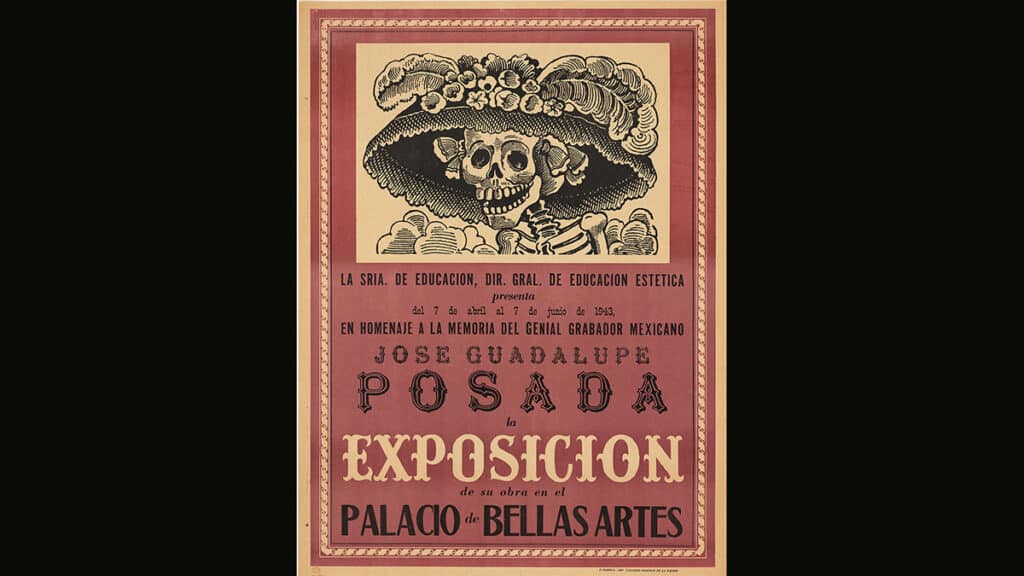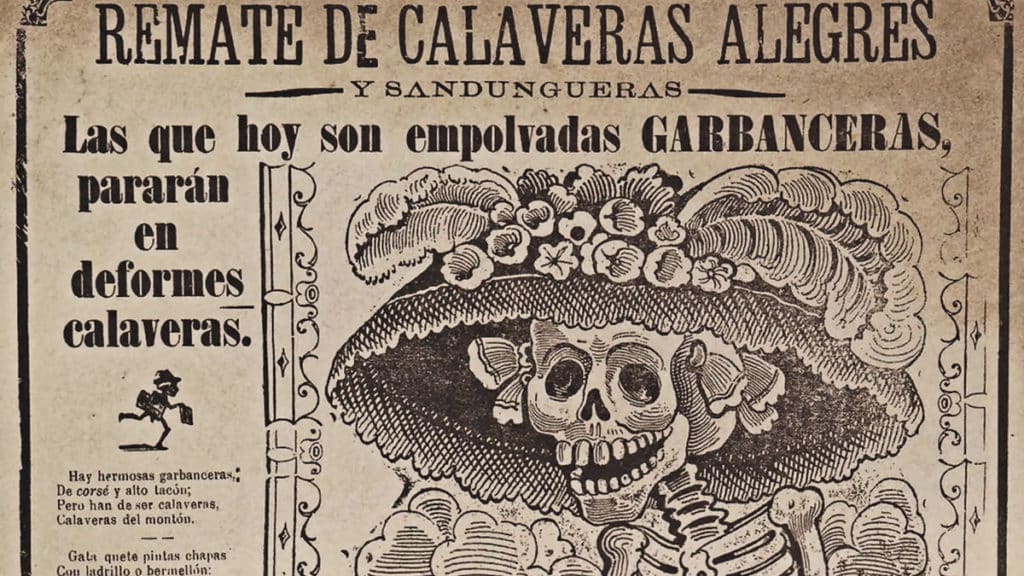Mexican Prints at the Vanguard is an art exhibition that explores the historical use of Mexican printmaking to address social and political issues, and promote a Mexican identity. It’s important because Mexico was an incredibly diverse, mostly rural society that was created from a former colony during periods of tremendous social change. In an unspoken way, the exhibition also highlights how much the United States and Mexico influence each other.

Unidentified Mexican artist, Exhibition of works by José Guadalupe Posada at the Palace
of Fine Arts, Mexico City, 1943. Printed by Talleres Gráficos de la Nación, Mexico, D.F.
Lithograph The Metropolitan Museum of Art, New York, Gift of Walter Pach, 1944 (44.88)
Mexican Prints at the Vanguard
Mexican printmaking traditions are related to Mexican murals which were a potent pre-literate form of teaching, and as both mural-making and graffiti art, remain an important expression of the people across the Latin world, and even in American art. The Whitney Museum of American Art has said that the main influence on American art was not the Europeans, it was the Mexican muralists.
Printmaking is commercial art, but the quality of the work and it’s influence on society raise the graphic arts to the level of fine art with broad impacts. The poster for the Posada exhibition is a great example of this. Latins love to make fun of life because it can be hard, and one of the best ways to get through it is to laugh at it all.
Posada’s Skull Catrina

Mexico is a country of Indigenous Peoples with a Spanish colonial overlay. Colonized peoples are taught from birth that the colonizer is good and everyone else is bad, so elites try to emulate the colonizer.
José Guadalupe Posada drew his Skull Catrina image around 1910-1912 as satire to mock Mexicans who pretend to be European, sell European products, and even powder their faces. It’s a commentary on the notion that in death we are all equal.
Charlot’s Skull Catrina
The skull face is a reference to the skull racks of Mixteca (Aztec) and Maya Day of the Dead traditions, but Catrina wears a European hat and has a white face. The original print was mostly forgotten, until French-born Mexican artist Jean Charlot put the image in a book in 1930. (The Met’s Mexican print collection is based on Charlot’s collection.) The image made the cover of an Art Institute of Chicago exhibition catalog in 1944, and was widely distributed in Mexico.
Diego Rivera’s Skull Catrina
In 1946-47, the great Mexican muralist Diego Rivera drew Skull Catrina in his famous mural “Sueño de una Tarde Dominical en la Alameda Central” (Dream of a Sunday afternoon in the Central Alameda). Rivera placed Skull Catrina in the center of the image among Mexican historical figures. She wears a European hat and an Indigenous Tehuana skirt. Her feather boa with a snake head is a reference to the Mesoamerican god Quetzalcoatl. Rivera drew himself as a boy holding Catrina’s hand. He is saying that he is just a student of Mexican tradition. Diego drew his now-famous wife, Frida Kahlo, as an adult right behind himself. He may have been saying that he learns from her too. Today Frida is more famous than Diego.
Mexico’s Day of the Dead Has Gone Global
Skull Catrina is now world-famous and a core inspiration for modern Mexican Day of the Dead traditions. She is so well known that one might think Day of the Dead is a Mexican tradition. It is actually a pan-Latin celebration and other cultures have their own wonderful Day of the Dead traditions.
Mexico and the United States are Sister Countries
Two thirds of the United States were once Mexico, so we inherited a lot of Mexican culture.
In the Day of the Dead, there is another twist on the way the United States and Mexico influence each other. In Mexican Spanish, Day of the Dead is “Día de Muertos.” It got translated into English as “Day of the Dead.” That got translated back into Spanish as “Día de los Muertos” which has become common usage in the United States.
Americans and Mexicans argue like brothers and sisters, but at the end of the day we are family.
PS: Mexico used the arts to craft a post-colonial Mexican identity. ¡Viva México! Now that we have begun decolonizing our own American heads, the Metropolitan Museum of Art and other New York cultural organizations are using the arts to help us craft a post-colonial American identity. We have the second-largest Spanish-speaking population after Mexico. ¡Viva Los Estados Unidos!
Mexican Prints at the Vanguard Tickets
Mexican Prints in the Vanguard is at the Metropolitan Museum of Art in Manhattan’s Upper East Side; from September 12, 2024 to January 5, 2025. Included with museum admission. $30, or pay-what-you-wish for New York State residents and Tri-State students.
